Dealing with hollow macaron shells? Here are the top reasons why your French macarons are hollow and how to fix them.
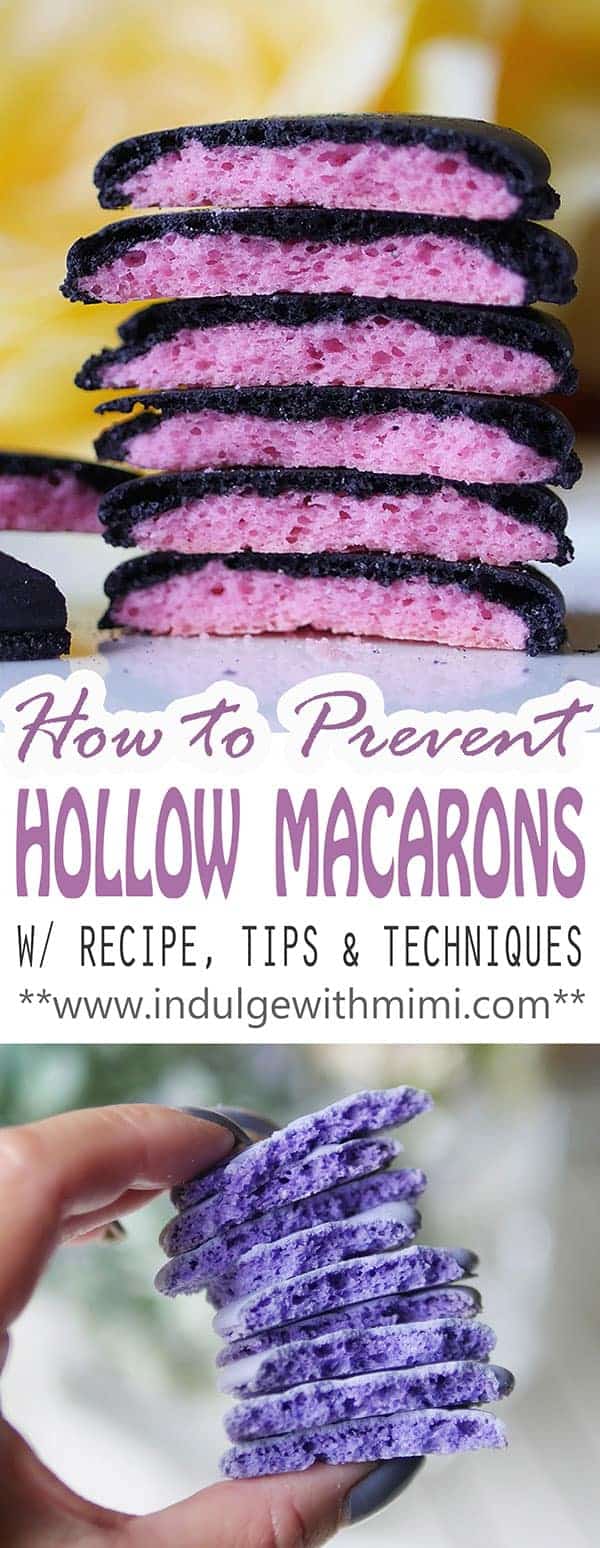
The Trouble with Hollow Macarons
Most bakers start to notice the issue of hollow macarons later in their macaron baking journey. When most bakers begin baking this little French treat, most are likely trying to overcome common hurdles like cracked macaron tops and bumpy shells. As a result, most tend to covet smooth non-cracked shells and frilly macaron feet above all else. But as their macarons start looking better - on the outside anyways - they realize there's a hidden issue that lies deep within their macarons - hollow shells.
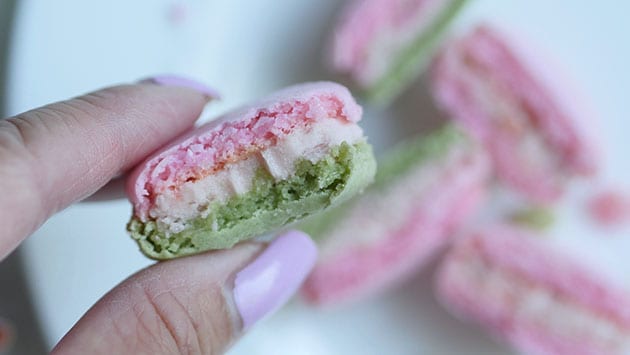
Do Hollow Macarons Go Away with Maturation?
Severely hollow macarons cannot be fixed with maturation. If most of the body has burst out of the shell and into the feet or sank down to the bottom causing a huge gaping hole, no amount of maturation will really help these types of macarons. Pressing into the back of the shells in order to push the body back up to the top - which some bakers do to deal with hollows - may be a temporary solution. But, ultimately, it's worth fixing hollow macarons since there is something inherently wrong with the baking technique.
A truly non-hollow macaron is not hollow even before filling and maturation as shown in the video above. If it's just a small gap in the macaron shells, these do benefit from filling and maturation, yay! You'll find that they can completely go away after 24 hours of maturation.
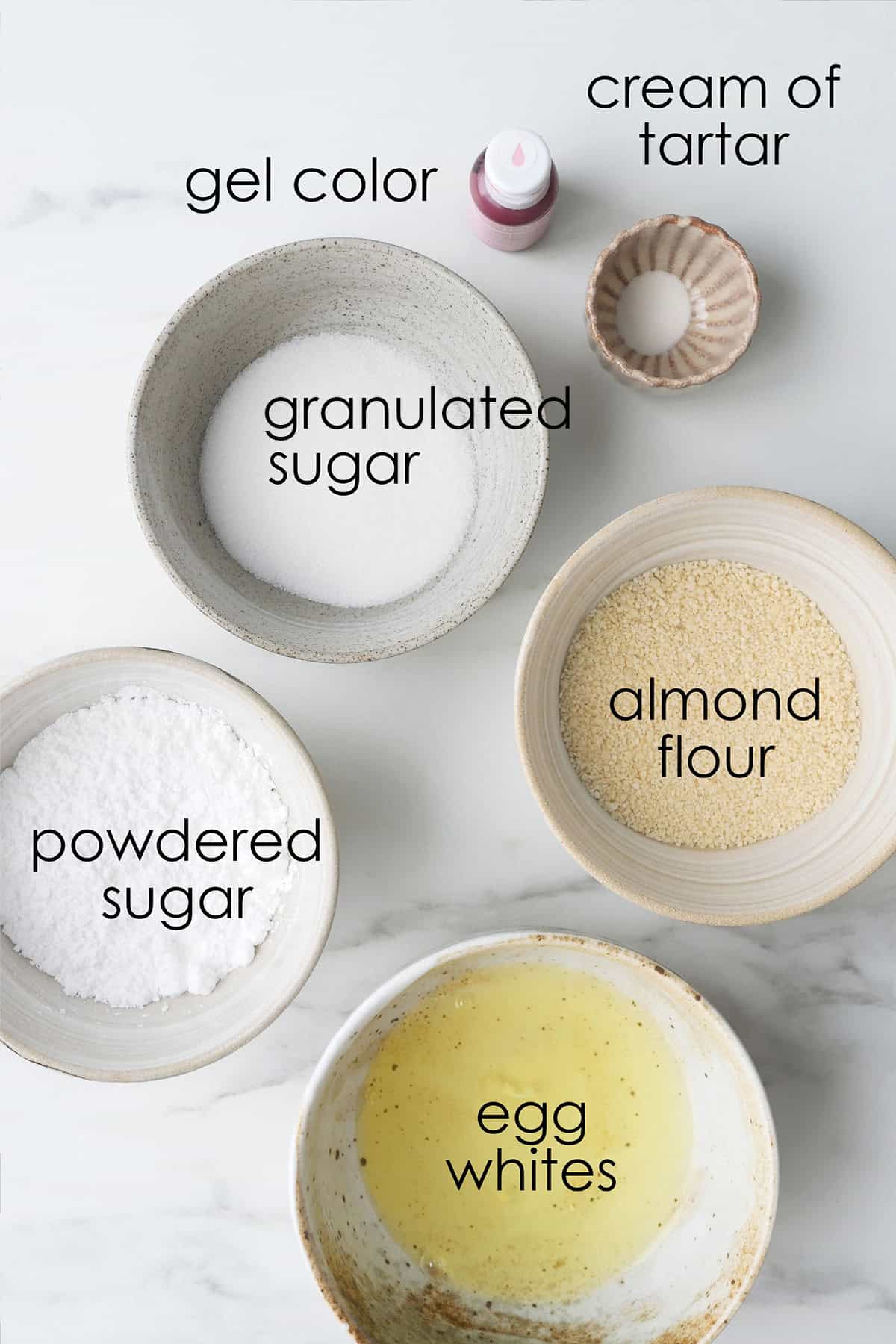
Should I Fix Hollow Macarons?
Having said of all that, it's important to remember that hollow macarons are not a problem for most people who eat your macarons unless they're macaron snobs and to which I say, why are you sharing your precious babies with those people anyways 🙂
All kidding aside, although hollow macarons may taste the same as non-hollow ones, severely hollow macarons are more fragile and lack the distinctly chewy texture of a full and fluffy macaron. Those are two of the reasons why you might want to work on your hollow macarons. But if you're obsessed with non-hollows for the glory, save yourself the frustration. It's important to remember that no matter what they look like, macarons are for eating!
For those who are keen on fixing this problem. Below are some key issues to look out for.
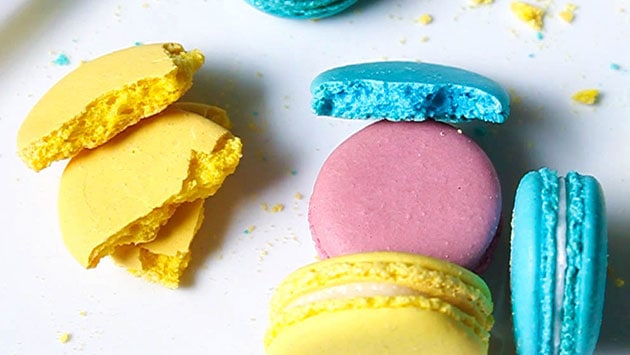
How Do I Fix Hollow Macarons?
Hollow macarons can be fixed by whipping the meringue to the correct stiffness, folding the batter to the ideal consistency during the macaronage stage, rapping the tray after piping, using the correct tools, baking at the optimal temperature and possibly the addition of a "secret" ingredient.
Meringue Stiffness
Over-beating the meringue can cause macaron shells to deflate while baking, resulting in a hollow shell. A good stiff meringue is required for my best recipe, however, over-beating the meringue can have an adverse effect and lead to hollow macarons. This is especially true if your macaron looks almost perfect in every way except for a little gap inside the shell.
If your macarons are looking fabulous in every way already (dainty feet, smooth tops), then this fix is for you. Beat the meringue up to the stiff peaks stage and stop immediately once it has been reached. If you are worried about overwhipping, you can skip the mixer and whip the meringue by hand. Yes! It can be done, check out How to Make Macarons without a Mixer and fancy tools.
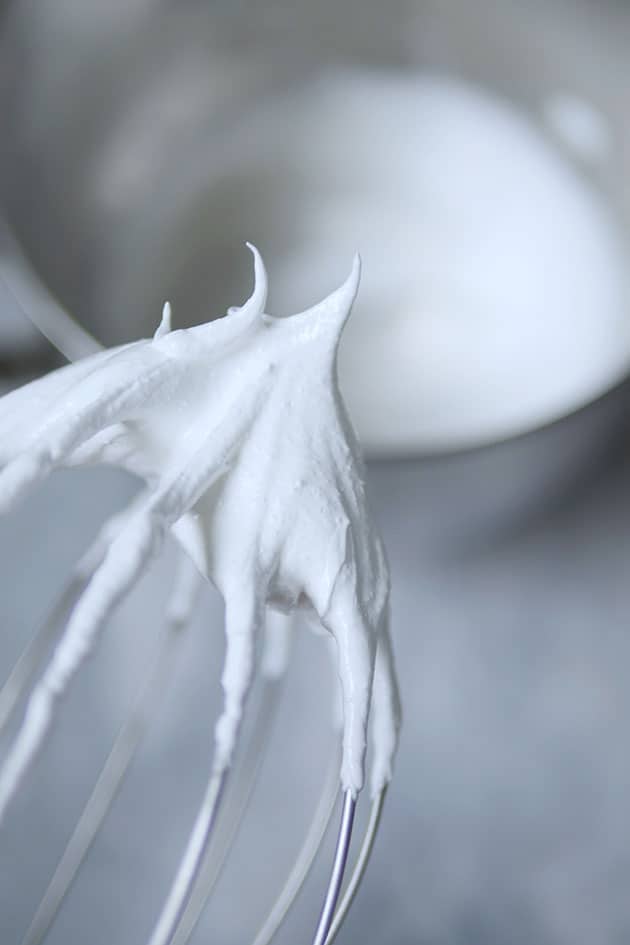
How Stiff is Stiff Peak?
Beat the meringue until a small peak points upwards when you pull the whisk out of the meringue. The peak can be small! If you beat until a big clump of egg whites can point upwards, you are probably over-beating. This is worth mentioning as some of you may have been trying to test the peaks with a lot more meringue than is needed.
Another way to scale back on how much you have been beating your meringue is to test the bowl by tipping it upside down. Once the egg whites can cling securely onto the bowl without slipping and you have a SMALL stiff peak, stop beating the meringue.
It's very important to create a stable foundation for your macarons and a lot of it starts with the meringue. The speed at which the meringue is whipped and the temperature of the ingredients also play a role. Take a look at the following post to learn more on how to make meringue for use in macaron baking.
FURTHER READING: HOW TO MAKE PERFECT MERINGUE FOR MACARONS
Folding During Macaronage
The macaron batter should be properly deflated to prevent hollows. If you tend to over-beat the meringue, this will help you counteract that. In the beginning of our macaron baking journey, we were told to be careful with deflating the batter. "It's better to under-fold than over fold,"...etc. But that's where a lot of hollow macaron problems begin - from an under-deflated batter. When you're folding the batter, you don't need to baby it as much as you think. Here is a video on how to fold properly to avoid hollows:
Proper Macaron Batter Consistency
On the flip side, over-folding can also cause hollow macarons and feet that are widely spread apart. When folding during the macaronage stage, constantly test the batter using the Figure-8 test in the video above. The batter should flow steadily without breaking but it should not be too runny either. Aim for a thick honey-like consistency. Here is what to look for in terms of consistency during and after piping:
Rap Tray
Rapping the tray after piping will further eliminate the small gaps in the shells that lead to hollows. Make sure you are tapping it hard enough against a hard surface. In the macaron class I took, the instructor literally dropped the baking trays from waist level down onto the floor. It's quite a violent action and sometimes the shape of the shells do change after rapping. For that, I recommend piping on Silpat mats which are great for retaining the shape of the macaron. Pop any remaining bubbles with a toothpick.
Silpat Mats
Silpat silicone mats are great for retaining the macaron's shape. There are many cheaper silicone mat alternatives out on the market now but I recommend using the Silpat brand. I trust them to have the highest degree of food safety. Also, they are reliable for conducting enough heat to reach the bottom of the macaron shells which helps with reducing hollows. Disclosure: Affiliate Links
Silpat Mats: 11 ⅝ X 16 ½ is the size I use in all the videos showing one single mat on a pan. SILPATS are is the only mat brand I use for baking macarons. This mat has no preprinted templates on it so it's great for using over my free macaron art templates.
Toaster oven sized Silpat mats: are perfect for counter top ovens. I sometimes place two of these on one tray to bake two different sized macarons shells at once. You can easily take out one mat earlier once it's done, leaving the other mat to bake longer. SILPATS is the only mat brand I use for baking macarons.
Bake Time & Temperature
Meringues and by extension, macarons, love heat! Give it as much oven love as you can and you'll see less hollow macarons in your kitchen. You can do this by using a:
a.) higher temperature OR
b.) lower temperature with a longer bake time
325 F for 12-14 minutes is a great place to start. (I know of a baker who likes to go even higher at 350 F for 10 minutes.) I must admit, this is quite a high temperature. Most readers have found that 325 F or higher can cause their shells to become browned so another temperature/time combo I can recommend is 275 F for 18 minutes. You can play with the time/temperature combinations. For every 25 F, compensate with a 2-3 minutes change in the inverse direction.
Some Recommended Baking Temperature and Times for Perfect Macarons:
350 F for 10 minutes - suitable for spacious large ovens
325 F for 12-14 minutes - standard starting point for use with my recipe
300 F for 16-18 minutes
275 F for 18-20 minutes - suitable for smaller ovens with small compartments
FURTHER READING: HOW TO USE YOUR HOME OVEN PROPERLY TO BAKE MACARONS
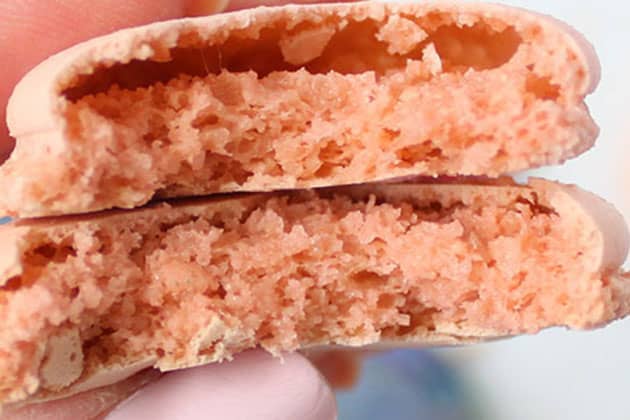
Silpats VS. Parchment VS. Teflon
Some bakers complain about hollows when using Silpat mats and have given up on them completely even though Silpats produce much better results in terms of retaining the macaron's shape. Sometimes Silpats don't perform as well for fully fluffy shells because of the related issue discussed in the last section: heat. The mats are thicker than parchment paper and don't conduct heat nearly as well.
There are a few adjustments that can be made to compensate for this:
- Use better heat conducting baking pans.
- Put it closer to the heat source if your oven's heating coils are on the bottom.
- Try Teflon paper which better conducts heat.
- Keep a pizza stone underneath the baking tray.
Heavy-duty baking pans: This is the cookie sheet I use. It's constructed of aluminized steel, the material of choice for commercial bakeries. It is also heavy duty so it won't buckle while baking . It is also rimless allowing even air flow to the macarons.
Teflon baking sheets: These are great for conducting heat and provides macaron shells the heat that some ovens lack. A great compromise between parchment paper and silicone.
Pizza Stone: A pizza stone in the oven can help stabilize oven temperature for temperamental ovens and provide heat from the bottom.
Convection VS. Non Convection for Macaron Baking
You don't have to get too hung up over whether or not to use the convection setting to bake macarons. I've had both types of ovens and they have both performed equally well for baking macarons. If your batter is at the right consistency, you can bake non-hollow macarons in both a convection or non-convection oven granted that you have found an optimal temperature and bake time. Consistent high temperature is key using the tools provided above. Keep an external oven thermometer to keep track of the temperature in the oven. Keep oven doors closed as much as possible and do a longer pre-heat if needed to reach that consistent temperature. Sometimes it takes a little longer to pre-heat to a consistent heat level.
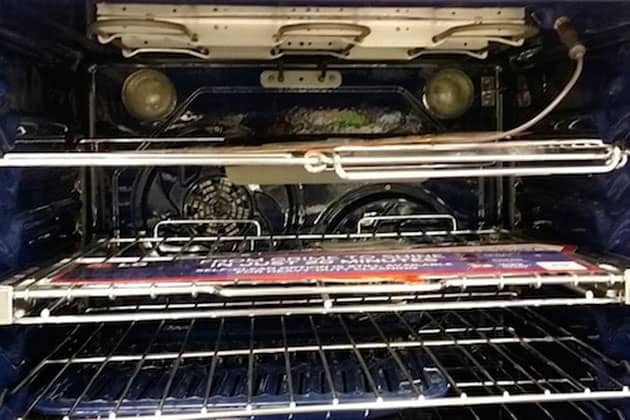
Magic Ingredient for Non-Hollows?
Although, technically, you should be able to overcome hollow macarons with the right techniques as mentioned above, there is one special ingredient you can consider. There's a lot of buzz around adding egg white powder to the dry ingredients to help combat hollows. I haven't tried it yet but it's something that some bakers have discovered worked for them. If all the above fixes don't work for you, you might want to give it a try.
Please note, egg white powder is NOT the same as meringue powder. Meringue powder contains a mixture of sugar, acids and flavorings while egg white power is just purely egg albumen.
My Secret for Testing Macaron Doneness
If you lower the oven temperature as per above, it's important that you bake for a longer amount of time, otherwise, the meringue will collapse after it cools. How to test the macaron for doneness? I'll cover it in an upcoming post. Stay tuned!
I hope you found this post useful and let me know below if you have any further questions.
XOXO,
Mimi
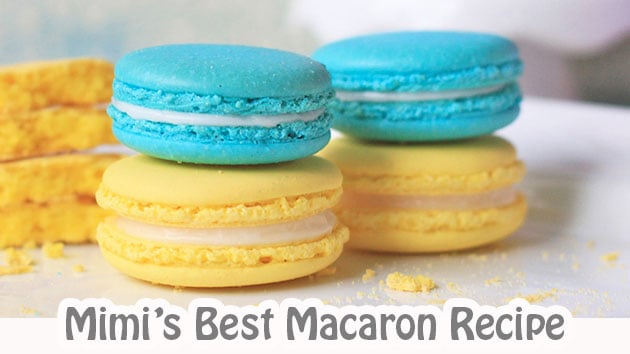
[pt_view id="f56aea0p7b"]

Gee says
Hey Mimi, I recently got a new convection oven and I noticed my feet keeps lifting while baking, so they are not straight. Do you have a fix for this? Thank you!
Mimi says
Hi Gee,
You oven might be too hot due to the convection setting. Have you tried setting it to a lower temp?
XOXO,
Mimi
Steve says
I can usually achieve good egg whites where they are whipped with good peaks and wont fall out of the bowl. then when I go to add vanilla and coloring I lose that consistency. Should I wait to add vanilla and or coloring after I fold in the drys?
Mimi says
Have you considered what type of coloring and flavouring you are using? Make sure to use GEL colours only and add it during the meringue stage to prevent overfolding. As for the vanilla extract, if you think it's interfering, I would recommend skip flavouring the shell altogether. You can get enough flavour from the filling through the maturation process. If you really want to add flavour to the shell, you can consider adding vanilla bean seeds in the dry mix. XOXO, Mimi
Linda says
Hey Mimi! Have you ever had your Macarons deflate after baking? I usually crack one open right after I take it out of the oven and its barely hollow inside. Later on when I bite in to another one when its completely cooled, and its super hollow. Do you know what might have happened and what I can do to fix it? Thank you!
Mimi says
It hasn't fully set during baking. You'll need to make sure the insides are fully baked before pulling them out of the oven. XOXO, Mimi
Linda says
I bake at 300 for 20 mins and they still dont set I guess. How much longer do I need to leave it in the oven? Thank you!
Mimi says
Why don't you try increasing the temperature just a bit. 20 minutes is quite sufficient for that temperature. XOXO, Mimi
Miyoung Lee says
Hi, Mimi.
Do you think aged egg white can fix hollow shells? I've tried every thing to fix hollow shell but all failed. The only method I haven't tried is aged egg whites. I'm not a novice in baking and make good meringue. Meringue, batter, shape is all like in your video. I've watched a lot of tutorial videos and read dozens of articles including Korean ones, and tried everything I can except aging eggs whites. It's because many people say room temperature egg whites still work. Now I wanna try last thing. If this doesn't work, I have to give up. No more ideas!
Mimi says
Aging egg whites by itself won't "fix" hollow shells but it can lead to an egg white with relaxed proteins that are easier to whip up without overwhipping which can cause hollow shells. I think it is worth it to age the egg whites since you can eliminate that as a factor in why you're getting hollow shells.
XOXO, Mimi
Miyoung Lee says
Mimi, I finally found a solution. I really want to share my experience here because a lot of people who think their meringue and batter is perfect are having same issues. The problem was the consistency of the heat in the oven.
I put the oven thermometer in the oven checked how temperature varies.
The temperature I wanted was between 280 to 300(higher than 300 is too high since my oven is small-Breville). But even if I preheated oven to 300, temperature didnt reach to 300.
So I preheated my oven to 350 and checked when it reaches to 300. It took 3 minutes after the 350 preheat beep to reach to 300(because I'm using bottom rack). When the temperature got 300, I put the pan into the oven and reduce the heat down to 310. After a few minutes, temperature in the oven went down a little bit to 290(because of uncooked macarons and door opening) and stayed there for 2 minutes, and then went up slowly again to 310 which I set. When it started to go up I adjusted temperature to 290, my ideal temperature, and stayed there until the cookies were done.
So from the start to the end, oven temperature was consistent, which was 290, although I preheated to 350 and adjusted to 310, and then finally 290. It really worked! For two weeks I have made macarons every day, more than five batches a day to fix the problem. Finally found a solution! I've tried once more and it worked as well.
Your temperature range information was helpful in guessing right temperature for my oven.
Not sure this will help others since my English is not good. Anyway a key point is to have consistent temperature in oven. Put your oven thermometer in oven, and study how you can make temperature consistent and steady in your oven from the start to the end of baking.
Thanks a lot, Mimi!
Mimi says
I'm so happy you were able to find a solution that works for you. And I want to thank you for coming back and sharing what worked for you with the other readers. I think some other bakers might find it insightful. I hope you enjoy baking even more macarons now!
Gee says
Hey Mimi, do you have a specific time for beating your egg whites? I do 7 1/2 minutes. I beat 4 for 4 minutes, then 6 for 2 minutes, then 8 for 1 1/2 minutes. I slice it after baking and its only a little hollow. When I try slicing alot later its super hollow. What happened there?
Mimi says
I don't have a specific time since every batch of egg whites might be different. It's always better to gauge the appearance of your ingredients rather than the time in determining when to move onto the next step in baking or even cooking. Having said that, you can try 2 minutes per speed starting at speed 3 until it gets stiff. XOXO, Mimi
Miyoung Lee says
Love your blog. I'm still having a problem with hollow macarons. I think I've made them hundreds times to fix the problem. I don't think I have a problem with the batter. I'm sure that everything is okay with my skill. Then, temperature can be a problem. I've tried various temperature range but still it doesn't work. I was looking for canadian recipe(i was using Korean recipe) just in case dry weather can affect the result and found your blog. The most informative blog I've found! Thanks for that. This blog is really helpful, but I haven't been able to fix the problem yet. So frustrating!
Mimi says
It sounds like you have been putting a lot of effort into this! I really applaud you! Practice really makes perfect and sometimes its a matter of finding the right technique for your oven and climate. I'm glad you found the resources useful! I wish you luck on your next batch 🙂 XOXO, Mimi
Patricia Morrish says
Hi Mimi
Wow, your two color macarons look awesome-- and no hollows! Speaking of hollows--
I am beginning to think its the colorant -- do you use a gel or dry powder colors? I've used both and colors seem to fade or change with baking. I seem to be caught in a sticky wicket-- If I don't use convection they don't rise and blow out at the feet or do the baseball cap slide.. If I use convection they brown on top. (I do use aluminum pans with silpat, the pans have a rim.) . I have hollows. All the time. Tried every modification and combination of modifications. I appreciate your article-- inspiration to keep trying. So, please help-- how to keep color true. Should I maybe use non-rimmed pans? That silpat gets screaming hot-- could that be it?
Thanks
P
Mimi says
Hi,
I use gel colors from Americolor. I find it to be very heat safe. There are other brands like Wilton which I have heard do not do well in the heat. Have you tried getting better heat conducting pans with no rims? I find the rims trap too much heat inside the baking area for macarons.
XOXO,
Mimi
Kat says
Hi Mimi,
Could you please share how much of the egg white powder you would use in your standard macaron recipe?
Thank you,
Kat
Mimi says
I have feedback from readers that they have used 1 tsp. Maybe you can start with that first. XOXO, Mimi
Laura G. says
I have seen picture of Macarons that have a different color inside than the shell. Not the filing but the cookie itself. How is this done?
Mimi says
It's a technique I created called for gender reveals. The tutorial is here. xoxo, Mimi
Stephanie says
Hi Mimi,
I love your recipe except when I double the recipe it never turns out quite right. What am I doing wrong??
Mimi says
You might not be familiar with the consistency of the egg whites and the batter. You may need to re-guage how stiff the egg whites should be and how much to fold the batter. There should be no problems at all by doubling, tripling, quadrupling my recipe. XOXO, Mimi
Amelia Baljit says
Hi Mimi. I did everything right, but when I baked at 160°C, all the shells cracked and some developed feet. What am I doing wrong?
These are my measurement:
1 cup confectioner's sugar
3/4 cup Almond flour
2 egg whites
1/4 cup sugar
Mimi says
Hi Amelia,
First of all, I would recommend using a scale to measure out the ingredients in a macaron recipe. I would not use a macaron recipe that uses cups instead of weights. There is too much room for error with macarons and you want to eliminate the factor of wrong ingredients first.
XOXO,
Mimi
Mimi says
Wow! I couldn't believe how nice these look! Thanks for sending these to me!

Mimi says
Thanks for sending me these photos of your macarons @bakedbymysh:
Linda says
Hiya Mimi, ive been having some hollow trouble with my macarons which saddens me greatly because my macarons used to be semi full - full but nowadays its hollow. I always follow the recipe to the letter and follow all techniques properly like 'stop when stiff peaks', 'stop folding when batter fall into 8 shape', 'tapping tray' and 'leave to rest for 30 mins or more' and such but in the end my macarons become hollow; its so hollow to the point that you can pop the top off with your pinky. I have a feeling it might be my oven but im not too sure. Its an electric oven i think, with lots of functions, ive been using the fan forced function at 160°C between 15 - 18 mins in the middle rack and nowadays its either semi-hollow or all hollow, its just wont be fully filled. Please tell me what im doing wrong!
Mimi says
If you haven't had any problems with hollows in the past with your oven, you might want to focus more on the techniques. The meringue might be whipped too much and later underfolded.
Noorie Grace says
This is a great article! Thank you! I will try these tips. I think my problem is the meringue consistancy, i may be under beating the eggs. My macarons ALWAYS come out hollow...they look and taste great, but it would be nice if they had the right consistency inside 😛
Mimi says
Keep going!! I hope you found some improvements 🙂
xoxo,
Mimi
meida says
Hi Mimi,
I hope you will be able to help with my hollow macarons.
I baked with the william sonoma gold pans and silpats at 300 degrees F, and I think there is not enough heat on the bottom of the macarons as the pan is too thick, the macarons turned brown too at that temperature. I tried with parchment paper at 275 degrees F, they came out not hollow but the shape of macaron is not round and the inside deflates after a while.
Do you think the pizza stone will be the fix of my problem? Will it help to conduct more heat to the pans? I bought Teflon sheets and the macarons were hollow too. Thank you! I'm so desperate!
Mimi says
I like the sound of your second baking temp at 275. If they are not hollow when they come out that is a good start. You just need to bake them longer so they don't collapse after cooling. I'm not sure why the temperature will cause your macarons not be "round"... maybe you can tell more about that. Pizza stone just keeps the temperature more stable, If you really wanted to, you could put the pan right on the pizza stone to see if it could conduct more heat but I find that setup can actually be too hot for the macarons.